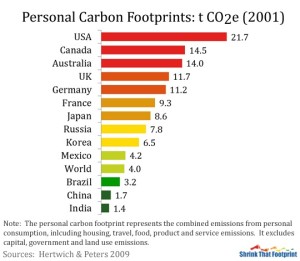
As the above table shows the carbon footprint generated by a US citizen is 15 times more than that generated by a Indian citizen. As rise in carbon footprint even through personal/individual activities affects climate change, so efforts should be made to cut down personal carbon footprint. Offsetting the CO2 emissions/carbon footprint is a practical way to make personal contribution towards reducing the effects of climate change. CO2 emissions/carbon footprint can be offset by use of cleaner energy sources. CO2 emissions/carbon footprint can be reduced by a number of ways; whether it is driving a car, cooking food, using electrical/electronic equipment, using better fuel.
Cut Carbon Footprint while Driving Car
• Alternative to Driving. if possible, take a walk or ride a bicycle can help cut carbon emissions. Carpooling and use of public transport can also help drastically reduce CO2 emissions.
• Use Low Carbon Vehicle. High mileage doesn’t mean low CO2 emissions. Electric cars don’t emit CO2 if they’re fully charged with electricity.
• Driving Style. Unnecessary acceleration reduces mileage by 33%, resulting in wastage of gas and money, and increasing carbon footprint.
• Shift to High Gears Soon. If you are driving a manual gear car, shift to higher gear.
• Tire Inflation and Other Tuning. Properly inflated tires help improve mileage by upto 3%. Use of correct grade of motor oil, tuned engine, can increase fuel efficiency by 40%.
• Drive Hybrid. A hybrid vehicle helps in saving cost incurred on fuel.
Reduce Carbon Footprint of House
• Use Proper Appliances. Make use of energy efficient products especially products with higher ENERGY STAR labelling ensure superior efficiency.
• Lighting. Turn off lights when not in use also better to replace incandescent bulbs with compact flourescent or LED bulbs.
• Air Conditioner. Don’t set it too high or low. Install a programmable model to turn off heater/air conditioner when not in home.
• Use Solar Power. Start using solar panels in home, though seems costly initially over time returns make investment free and generate electricity for free.
• Unplug Phone Charger. Leaving the phone charger on the socket after phone is charges increases CO2 emission/carbon footprint, better avoid it.
• Buy Laptop than Desktop. Laptops use upto 80% less energy than desktop, unless high speed processor.
• Close Curtains. In winter’s when heater is on open curtains during the day and close them at night and save up to 75% on power.
• Use Rechargeable Batteries. Using rechargeable batteries can cut upto 1,000 pounds of your carbon footprint.
Reduce Carbon Footprint While Making Food
• Eat Locally-Produced Organic Food. Greenhouse gas emissions can be reduced by eating locally produced organic food as transporting food requires use of petroleum-based fuels, and even fertilizers are fossil fuel-based.
• Microwave the Food. Microwave is more efficient than gas/electric stove; even though for large meals a stove is a better option.
• Eat In-Season Produce. Out of season produce increases cost of refrigeration; so better to eat in-season food.
• Plant Organic Garden. Growing own organic food in own garden is better option as it allows monetary savings and helps cut CO2 emission.
Other Ways to Cut Carbon Footprint
• Cut Water Usage. Lower the use of water by washing car less often, use plants that use less water in your garden, install drip irrigation for plants, purchase equipment that further cut water use.
• Reuse and Recycle. CO2/greenhouse gas emissions are considerable due to efforts put in extraction, manufacturing, transportation, disposal of “goods” including consumer products and packaging. Buying used products and reselling or recyling items no longer in use, can reduce carbon footprint.
• Support Clean Energy Sources. Using clean alternatives to fossil fuels, such as wind, solar, wave, hydroelectric, biomass, geothermal energy can help cut CO2/greenhouse gas emissions considerably.
• Create a Wormery. Creating a wormery that mostly like to feed on trash, can also be beneficial as they can turn trash/waste/rejects into fertilizer.
• Buy Certified Wood. Buying certified wood that comes from responsibly managed forests; where forests are monitored to prevent deforestation and maintain biodiversity s also beneficial.
• Plant a Tree. Planting a tree not only helps the environment by providing shade and oxygen but consumes CO2.
It can be safely said that there are many ways to cut CO2/greenhouse gas emissions. Whether it is opting for carpool, growing own vegetable, eating in season, using renewable and clean source of power, everything depends on the viability of the options over previously used methods. Even though some of these options may be costly initially, but in the long the cost is reduced considerably and ultimately start generating returns on investment, only thing to consider is the time it takes to generate result.


It has taken decades of public awareness programmes and educational
literature to make people start to take responsibility for the environmental
disasters that have been caused by lack of waste management and recycling.
Many households now have a specific bin for rubbish and at least one more for
recycling, in some progressive areas separate bins for paper, glass and plastic is
common. The reason that this is so important is because
those electronics can contain materials such as mercury or lead, which can be harmful not only to human beings, but also
to the environment.
I ǥotta favorite this web site it seems extremely helpful very beneficial
dear sir/madam
thanks for the appreciation for writing a good blog.
we do like to share useful information on solar power and renewable energy and technology and add our perspective.
keep watching this space for the latest blog updates.